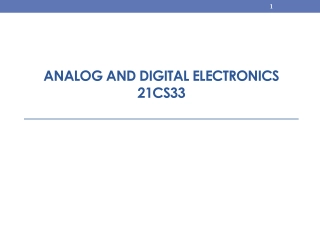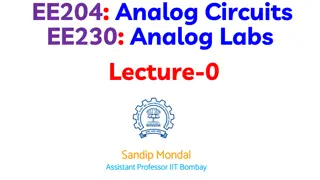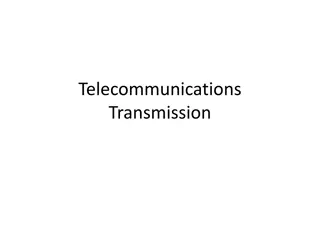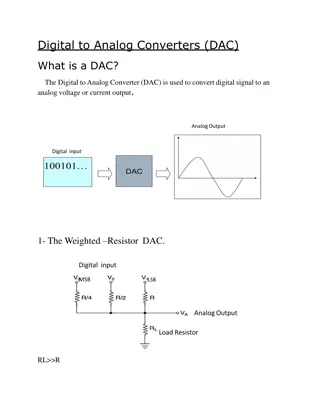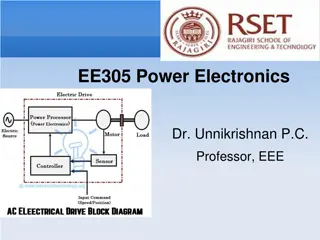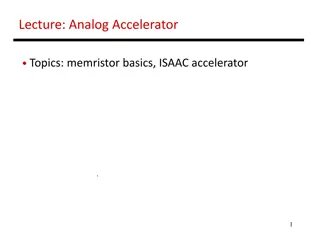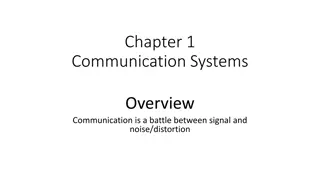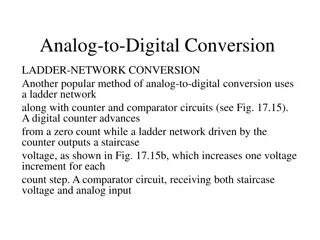Analog Electronics in Neural Circuits Research
Analog electronics with control knobs for biological mechanisms in neural circuits, including nanotechnologies, astrocyte-neuron interactions, structural plasticity, and neural network learning capabilities. Understanding the intricate relationship between neurons and glial cells in brain function and repair through retrograde mechanisms."
Download Presentation

Please find below an Image/Link to download the presentation.
The content on the website is provided AS IS for your information and personal use only. It may not be sold, licensed, or shared on other websites without obtaining consent from the author.If you encounter any issues during the download, it is possible that the publisher has removed the file from their server.
You are allowed to download the files provided on this website for personal or commercial use, subject to the condition that they are used lawfully. All files are the property of their respective owners.
The content on the website is provided AS IS for your information and personal use only. It may not be sold, licensed, or shared on other websites without obtaining consent from the author.
E N D
Presentation Transcript
parker@usc.edu http://ceng.usc.edu/%7Eparker/BioRC_research.html
Analog Electronics with control knobs for biological mechanisms Nanotechnologies Astrocyte - Neuron Interactions Large, Noisy Nonlinear Neurons Structural Plasticity
First use of nanotechnologies In neural circuits (in Chongwu Zhou s Nanolab) Carbon Nanotube Transistor Now considering graphene, Molybdenum disulfide, others Vref = -1V Carbon Nanotube Synapse Experimental Results Vin Vout 10 M
Analog Electronics with control knobs for biological mechanisms Example synapse circuit with control knobs for neurotransmitter availability, receptor concentration and reuptake rate R
Analog Electronics with control knobs for biological mechanisms Neural Network A neural network that can learn 2X2 Sudoku and Sudoku-like games A 2 External inputs set up initial game A 1 B 1 A 1 A 2 B 1 B 2 Network is fully connected but synaptic strengths (neurotransmitter concentrations) can be adjusted by a trainer circuit using dopamine D 2 B 2 C 1 C 2 D 1 D 2 D 1 C 1 C 2 Trainer circuit contains the rules for the game Game Format In training mode, external inputs force correct answers to strengthen synapses
Neurons Astrocytes Astrocyte - Neuron Interactions Astrocytes stimulate, calm, synchronize and repair neurons There are 10 times as many glial cells as neurons in the brain Glial cells control blood flow and propagation speed Glial cells affect processing and memory
Repair via Retrograde Mechanisms: The Biology Inspired by mathematical models published by Wade, McDaid and Harkins The postsynaptic neuron signals the presynaptic neuron to reduce the transmitter release The astrocyte signals the presynaptic terminals of many nearby neurons to produce more transmitter
Repair via Retrograde Mechanisms: The Experiment Faulty Synapse
Repair via Retrograde Mechanisms: The Results N1, N2 and N3 are presynaptic to N4 S9 stops working and retrograde signaling is used to strengthen N4 s other synapses No Faulty Synapse so N4 Fires when expected S9 on N4 stops working but no retrograde signaling is used
Large, Noisy Nonlinear Neurons 104 synapses in cortical neurons Assume a simple threshold function for this type of neuron. Although there are N (104 ) inputs, we assume any combination of 300 active inputs can make the neuron spike. This requires 104 synapse circuits and about 104 2-input adder circuits, to sum the inputs. We need one axon hillock to perform the thresholding/spiking function.
Moderately-Large Neurons a hypothetical argument If we decide instead to model the same exact computation with simpler neurons that only have 300 inputs, there are N choose M or 10,000 choose 300 combinations of inputs that make the neural circuit fire at the final output. Thus, we require N!/(N-M)!M! combinations to be checked, so the first stage of the neural network has N!/(N-M)!M! neurons, each of which has M inputs. We could estimate the number of neurons in the first stage to ~NM? Therefore the number of synapses in the first stage of neurons is ~300NM In the large neuron the total number of synapses was N.
WECANBUILDELECTRONICNEURONSANDPARTSOFNEURONS: WITHSYNAPTICPLASTICITY THECONNECTIONSBETWEENNEURONSCANCHANGESTRENGTHS WITHSTRUCTURALPLASTICITY NEWCONNECTIONSCANFORMANDOLDONESCANDISAPPEAR THATDEMONSTRATEVARIABLEBEHAVIOR(STOCHASTICNOISEANDCHAOTIC) THATCONTAINBOTHEXCITATORYANDINHIBITORYINPUTS THATMIMICRETINALNEURONSWITHGRADEDPOTENTIALS OUTOFNANOTRANSISTORS CARBONNANOTUBES THATCOMMUNICATEWITHASTROCYTES(AFORMOFGLIALCELL) FORLEARNINGANDSELF-REPAIR WITHDENDRITICCOMPUTATIONS WECANADDINPUTSINACOMPLICATEDMANNER, INCLUDINGDENDRITICSPIKING WITHDENDRITICPLASTICITY THEADDITIONSOFINPUTSCANVARY WECANBUILDSMALLNEURALNETWORKS, INCLUDINGMODELING OCD, MS, SCHZOPHRENIC HALLUCINATIONS, C. ELEGANSTOUCH-SENSITIVE NETWORK
Ph.D. Students Ph.D. Students Saeid Barzegarjalali Learning and Memory Jasmine Berry Self Awareness in Movements Rebecca Lee Astrocytes Pezhman Mamdouh Power reduction in large neurons Kun Yue nanotechnologies/noise Ph.D. Graduates Ph.D. Graduates Yilda Irizarry-Valle, John Joshi, Adi Azar, Ko-Chung Tseng, Chih-Chieh Hsu, Jason Mahvash, Ben Raskob
Thank You Thank You


